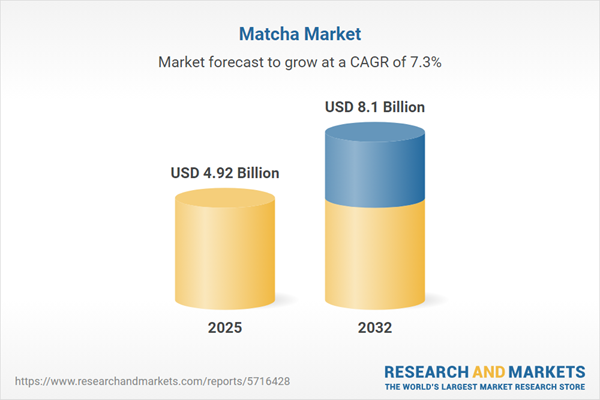Speak directly to the analyst to clarify any post sales queries you may have.
The matcha market is experiencing significant evolution as diverse sectors from foodservice to wellness capitalize on its rising global influence. Strategic decision-makers are reevaluating sourcing, segmentation, and innovation in response to shifting consumer motivations, complex supply chains, and intensifying regulatory landscapes.
Matcha Market Snapshot
The matcha market grew from USD 4.59 billion in 2024 to USD 4.92 billion in 2025 and is projected to reach USD 8.10 billion by 2032, with an expected CAGR of 7.33%. Market momentum is driven by increasing demand for versatile matcha formats, wellness-oriented consumption, and expanding retail channels. Leading brands are leveraging premium positioning and clean-label strategies to build consumer trust and capture new value streams.
Comprehensive Scope & Segmentation
This report provides a deep analysis of the matcha ecosystem, focusing on the following segments and regions:
- Grade: Ceremonial, Culinary, Ingredient—accommodating premium tea experiences, foodservice applications, and large-scale manufacturing ingredients.
- Form: Capsules, Leaf, Powder, Tablets—meeting consumer preferences for supplement, artisanal, and blendable options.
- Application: Beverages (latte, smoothies, tea); Confectionaries (bakery, chocolates, desserts); Cosmetics (haircare, skincare); Dietary Supplements—enabling portfolio diversification across categories.
- Distribution Channel: Offline (convenience stores, specialty stores, supermarkets); Online (brand website, e-commerce platforms)—supporting both immediate accessibility and content-driven engagement strategies.
- End User: Foodservice (cafés, hotels, restaurants); Household—addressing both B2B procurement and consumer purchasing drivers.
- Regional Coverage: Americas (U.S., Canada, Mexico, Latin America); Europe, Middle East & Africa (including the UK, Germany, France, and others); Asia-Pacific (China, India, Japan, Australia, and key regional markets).
- Company Coverage: Includes detailed analysis of Aiya Co., Ltd., AOI Tea Company, Associated British Foods plc, DavidsTEA Inc., Harney & Sons Fine Teas, LLC, Unilever PLC, Nestle S.A., and other global players.
Technology and Innovation Focus
- Processing Techniques: Advanced post-harvest handling, third-party testing regimes, traceability systems.
- Sustainability Initiatives: Regenerative agriculture, supplier audits, carbon and water footprint assessments.
- Digital Commerce: Data-driven e-commerce, direct-to-consumer analytics.
Key Takeaways for Strategic Leaders
- Premiumization has become essential, with brands investing in origin transparency and sustainable sourcing to meet sophisticated customer expectations.
- Innovation in formats and applications enables expansion into new consumption occasions, including supplements, beverages, and confectionery.
- Sustainability and traceability now directly influence supplier choices and retailer acceptance, elevating the need for robust supply chain management.
- Intensifying regulatory scrutiny prompts investments in upstream quality control and certification to uphold compliance and brand reputation.
- Regional dynamics shape channel strategies: North America prioritizes wellness and provenance, EMEA balances premiumization and accessibility, Asia-Pacific drives origin authenticity and rapid retail innovation.
- Vertical integration, partnerships, and data-led commercial platforms underpin competitive differentiation and long-term resilience.
Tariff Impact and Supply Chain Resilience
- Recent tariff adjustments have led buyers to diversify supplier portfolios, optimize lead times, and hedge against geopolitical risk.
- Manufacturers are adjusting formulations and pack sizes to manage cost structures and maintain price accessibility.
- Import duties are expediting the shift toward nearshoring and domestic processing to strengthen control over quality and compliance.
- Integrated sourcing and scenario planning support margin protection and sustained end-user confidence amid evolving trade policy landscapes.
Methodology & Data Sources
This analysis employs a mixed-methods research design, incorporating primary interviews with growers, brand managers, foodservice buyers, and retail leaders. Targeted supply chain mapping addressed critical control points, while comprehensive secondary research synthesized regulatory guidance, trade literature, and patent filings. Expert reviews ensured validity and minimized bias, supporting transparent and reproducible insights.
Why This Report Matters
- Equip leadership teams with actionable strategies for supply resilience, innovation acceleration, and premium positioning in the growing matcha market.
- Enable informed sourcing, pricing, and product development decisions by clarifying channel preferences, regulatory pressures, and buyer motivations across major geographies.
- Support cross-functional alignment, optimizing procurement, R&D, and commercial operations for market adaptation and brand trust.
Conclusion
The matcha market’s evolution centers on authenticity, operational agility, and innovation. Success favors leaders who combine deep supply chain insight with scalable processes, enabling capture of emerging opportunities and long-term value.
Additional Product Information:
- Purchase of this report includes 1 year online access with quarterly updates.
- This report can be updated on request. Please contact our Customer Experience team using the Ask a Question widget on our website.
Table of Contents
3. Executive Summary
4. Market Overview
7. Cumulative Impact of Artificial Intelligence 2025
Companies Mentioned
The companies profiled in this Matcha market report include:- Aiya Co., Ltd.
- AOI Tea Company
- Associated British Foods plc
- DavidsTEA Inc.
- DoMatcha by Andrews & George Company Limited
- Harney & Sons Fine Teas, LLC
- ILEM JAPAN LTD.
- Ippodo Tea Co., Ltd.
- ITO EN, Ltd.
- Japan GreenTea Co.,Ltd.
- Keicha Tea World, Inc.
- Kettl, Inc.
- LifeTime Tea. LLC
- McCormick & Company, Incorporated
- Nestle S.A.
- Numi Organic Tea, LLC
- Riching Matcha
- Takezwa Seicha Co., Ltd.
- The Republic of Tea, Inc.
- Unilever PLC
Table Information
| Report Attribute | Details |
|---|---|
| No. of Pages | 186 |
| Published | November 2025 |
| Forecast Period | 2025 - 2032 |
| Estimated Market Value ( USD | $ 4.92 Billion |
| Forecasted Market Value ( USD | $ 8.1 Billion |
| Compound Annual Growth Rate | 7.3% |
| Regions Covered | Global |
| No. of Companies Mentioned | 21 |









